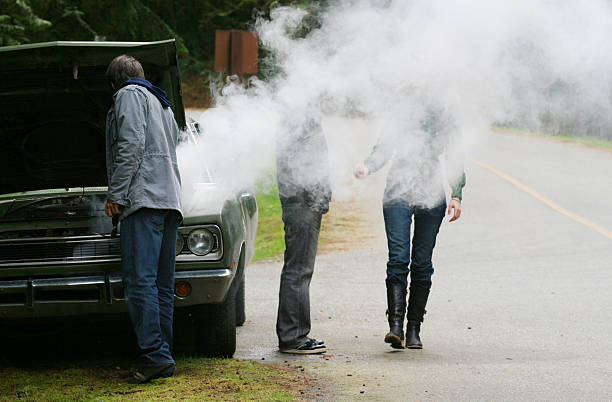One of the most frustrating and potentially dangerous situations a driver can face is a car overheating. It’s a scenario that can strike unexpectedly, leaving you stranded on the side of the road with a smoking engine. However, knowing what to do when your car overheats can make all the difference in resolving the issue quickly and safely. In this Blog, we’ll guide you through the steps to take if your car starts to overheat, and we’ll also explore the importance of having roadside assistance and a reliable battery installation.
Recognizing the Signs
Before delving into the actions to take when your car overheats, it’s crucial to recognize the signs of an overheating engine. Common indicators include a rising temperature gauge on the dashboard, steam coming from the hood, and a distinct smell of burning coolant. If you notice any of these signs, it’s essential to act promptly to prevent further damage to your vehicle.

Immediate Steps
Pull Over Safely
The moment you notice your car overheating, find a safe place to pull over. It’s crucial to avoid stopping on a busy road or in the middle of traffic. Look for a parking lot, a rest area, or the shoulder of the road where you can safely assess the situation
Turn Off the Engine
Once you’ve safely pulled over, turn off the engine immediately. This will let the engine cool down and help stop additional damage.
Pop the Hood
While the engine cools, pop the hood to allow heat to escape more quickly. Be cautious when doing this, as there might be hot steam or coolant under pressure. Wait for a few minutes before inspecting the engine.
Assessing the Situation
Check Coolant Levels
Open the radiator cap (only when the engine is cool) and check the coolant levels. If they are low, add coolant or water to the radiator. Keep in mind that adding water is a temporary solution; it’s advisable to visit a mechanic for a proper coolant refill.

Inspect for Leaks
Look for any visible leaks under the car. Leaking coolant could be a reason for the overheating, and it may require professional attention.
Check the Radiator Fan
Inspect the radiator fan to ensure it is functioning correctly. A malfunctioning fan can contribute to overheating issues. The fan might need to be replaced if it isn’t functioning.
Inspect the Serpentine Belt
A broken or slipping serpentine belt can lead to various engine issues, including overheating. Check the belt for any signs of wear or damage and replace it if necessary.
Call for Roadside Assistance
If you are unable to identify and fix the issue or if you are stranded in an unsafe location, it’s time to call for roadside assistance. They can provide towing services or on-site assistance to get your vehicle to a repair shop.
Importance of Roadside Assistance
Having a reliable roadside assistance service is invaluable in situations like these. Roadside assistance can provide prompt help when you’re stuck on the side of the road due to car troubles. Whether it’s a flat tire, a dead battery, or an overheated engine, a quick call to your roadside assistance provider can save you time, stress, and potentially expensive towing fees.
Roadside assistance offers various services, including jump-starting a dead battery, tire changes, fuel delivery, and towing. Many providers also offer additional benefits, such as locksmith services and trip interruption coverage. Investing in a roadside assistance plan ensures that you have a safety net when unexpected car issues arise, giving you peace of mind on the road.
Importance of Battery Installation
While overheating issues are often related to the engine, it’s essential not to overlook the role of the battery in your vehicle’s overall performance. A well-functioning battery is crucial for starting your car, powering electronic components, and supporting the charging system.
Maintain Your Battery
Regularly check and maintain your car’s battery. Ensure that the terminals are clean, free of corrosion, and securely connected. If your battery is more than three years old, consider having it tested or replaced to prevent unexpected breakdowns.
Professional Battery Installation
When replacing a battery, opt for professional installation. A qualified technician can ensure that the new battery is compatible with your vehicle and installed correctly, minimizing the risk of future issues.
Conclusion
Experiencing a car overheating can be stressful, but knowing how to respond and taking immediate action can help prevent further damage. Regular maintenance, such as checking coolant levels, inspecting belts, and ensuring a well-maintained battery, can also contribute to a smoother and safer driving experience.
Additionally, having access to roadside assistance is a smart investment for any driver. Whether you encounter a flat tire, a dead battery, or an overheated engine, knowing that help is just a phone call away can make all the difference in turning a potentially dangerous situation into a manageable one. So, stay informed, be proactive with maintenance, and ensure you have the support you need when the unexpected happens on the road.
FAQ
Why is roadside assistance important when your car overheats?
Roadside assistance is crucial when your car overheats because it provides prompt help in situations where you may be stranded on the side of the road. Whether it’s a flat tire, a dead battery, or an overheated engine, roadside assistance can offer towing services or on-site assistance, saving you time, stress, and potential towing fees.
Why is maintaining your car’s battery important in relation to overheating issues?
Maintaining your car’s battery is important in relation to overheating issues because a well-functioning battery is crucial for starting the car, powering electronic components, and supporting the charging system. Regularly checking and maintaining the battery, along with professional battery installation when needed, can contribute to overall vehicle performance and minimize the risk of unexpected breakdowns, including overheating.
